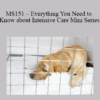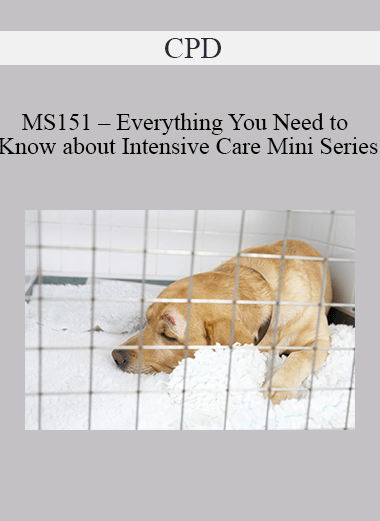$479.00 Original price was: $479.00.$114.00Current price is: $114.00.
 Purchase this course you will earn 114 Points worth of $11.40
Purchase this course you will earn 114 Points worth of $11.40Elevate your skills with the CPD – MS151 – Everything You Need to Know about Intensive Care Mini Series course, available for just $479.00 Original price was: $479.00.$114.00Current price is: $114.00. on Utralist.com! Browse our curated selection of over 60,000 downloadable digital courses across diverse Everything Else. Benefit from expert-led, self-paced instruction and save over 80%. Start learning smarter today!
Purchase CPD – MS151 – Everything You Need to Know about Intensive Care Mini Series courses at here with PRICE $479 $114
MS151 – Everything You Need to Know about Intensive Care Mini Series
£347.00 (+VAT)
12 months access to recordings and course materials is included. Please note that these are webinar recordings and not live events. Full details on how to access the Mini Series will be emailed to you.
- Join Alessandra Mathis DVM CertVA DipECVAA MRCVS for three 2-hour online sessions
- Comprehensive notes to downloaded
- Self-assessment quizzes to ‘release’ your 8 hours CPD certification (don’t worry, you can take them more than once if you don’t quite hit the mark first time)
- A whole year’s access to recorded sessions for reviewing key points
- Superb value for money – learn without travelling
- Watch the recordings on your iPad!
- This Mini Series was originally broadcast in July 2017
Programme
Session 1
Triage of the emergency patient
Triage is the initial assessment of the urgency and clinical status of the patient based on its severity of illness. This assignment should be performed in minutes and only the major systems of the patient should be assessed. In this session we will look into which parameters to assess for each of the major body systems, we will look at how to put them together and we will discuss the initial stabilisation of the critical patient.
What you’ll learn:
-
- Triage of the emergency patient
Oxygen-therapy and stabilisation of the dyspnoeic patient
- Fluid therapy
- Analgesia of the emergency patient
- Case discussion
The septic patient
Sepsis – a severe systemic inflammatory response to infection – is a frustrating life-threatening condition. Recognizing early signs of sepsis, understanding how to monitor a septic patient and finally knowing what treatment to provide is paramount to increase the likelihood of survival. What is an essential treatment? What else can you do for these patients? During this session you will learn how to approach the septic patient and what the latest treatment guidelines are.
What you’ll learn:
- Sepsis – definition and signs
- Treatment
- Goals – what should you aim to?
- Essential treatment – which fluids? Which drugs? And how much?
- What to do if you cannot get that blood pressure up? Which drugs are available and how to administer them?
- Supportive treatment
Cardio-pulmonary resuscitation (CPR)
You may have given the best treatment to your patient but things can still take a turn for the worse. What to do now? Nearly 95% of dogs and cats who arrest whilst in the hospital will not survive to discharge. The intensive care unit is probably the one place where cardiopulmonary arrest may occur more frequently. It has never been more appropriate to say that being prepared, organised and knowing what to do in such a circumstance is actually vital. How to perform correct CPR? What should you absolutely be doing? Which drug will make a difference? When to administer drugs? In this session we will discuss the latest CPR guidelines so that you can give the arrested patient the best chance to survive.
What you’ll learn:
- Preparedness – how to get your practice as prepared as possible for such an event?
- What is basic life support? How to perform chest compressions and how to ventilate the patient who has arrested.
- Advanced life support – you will learn what drug to give and when to give it. We will discuss the different arrest rhythms and treatments, how to administer fluid-therapy and what else can be done for the patient during CPR
- Knowing how to monitor a patient during CPR is paramount for decision making. What monitoring can you rely on? How long should you be doing CPR for?
Purchase CPD – MS151 – Everything You Need to Know about Intensive Care Mini Series courses at here with PRICE $479 $114
Cultivate continuous growth with the CPD – MS151 – Everything You Need to Know about Intensive Care Mini Series course at Utralist.com! Unlock lifetime access to premium digital content, meticulously designed for both career advancement and personal enrichment.
- Lifetime Access: Enjoy limitless access to your purchased courses.
- Exceptional Value: Benefit from savings up to 80% on high-quality courses.
- Secure Transactions: Your payments are always safe and protected.
- Practical Application: Gain real-world skills applicable to your goals.
- Instant Accessibility: Begin your learning journey immediately after buying.
- Device Compatible: Access your courses seamlessly on any device.
Transform your potential with Utralist.com!
Related products
Everything Else
= 56 Points
Everything Else
= 71 Points
Everything Else
= 56 Points
Everything Else
= 43 Points
Everything Else
= 89 Points
Everything Else
= 43 Points
Everything Else
= 52 Points
Everything Else
Brian Tracy – 21st Century Sales Training for Elite Performance
= 47 Points
Login

 Purchase this course you will earn 114 Points worth of $11.40
Purchase this course you will earn 114 Points worth of $11.40










